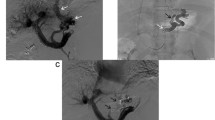Abstract
A new technique using cyanoacrylate glue is suggested for closing the transparenchymal tract following metallic endoprosthesis placement in a patient with malignant biliary obstruction complicated by ascites. With this technique, complications related to bile reflux through the transparenchymal tract would be avoided after transhepatic endoprosthesis placement in patients who have ascites. This technique would also be useful for avoiding bleeding following transhepatic portal venous puncture.
Similar content being viewed by others
References
Adam A, Chetty N, Roddie M, Yeung E, Benjamin IS (1991) Self-expandable stainless steel endoprostheses for treatment of malignant biliary obstruction. AJR 156:321–325
Mueller PR, Van Sonnenberg E, Ferruchi JT (1982) Percutaneous biliary drainage: Technical and catheter-related problems in 200 procedures. AJR 138:17–23
Nilsson U, Evander A, Ihse I, Lunderquist A, Macibob A (1983) Percutaneous transhepatic cholangiography and drainage: Risks and complications. Acta Radiol 24:433–439
Cumhur T, Ozmen MN, Akhan O, Olcer T, Cekirge S, Ozdemir E (1995) Malignant biliary obstruction treated with self-expandable metallic stents. Eur Radiol 5:6–12
Lammer J, Günther EK, Kleinert R, Hausegger K, Einspieter R (1990) Obstructive jaundice: Use of expandable metal endoprostheses for biliary drainage. Radiology 177:789–792
Ring EJ, Gordon RL, LaBerge JM, Shapiro HA (1991) Malignant biliary obstruction complicated by ascites: Transjugular insertion of an expandable metallic endoprosthesis. Radiology 180:579–581
Rösch J, Lakin PC, Ruza A (1973) Transjugular approach to liver biopsy and transhepatic cholangiography. N Engl J Med 289:227–231
Goldman ML, Gonzales AC, Galanbos JT, Gordon IJ, Oen KT (1978) The transjugular technique of hepatic venography and biopsy, cholangiography and obliteration of esophageal varices. Radiology 128:325–331
Hanafee W, Weiner M (1967) Transjugular percutaneous cholangiography. Radiology 88:35–39
Weiner M, Hanafee W (1970) A review of transjugular cholangiography. Radiol Clin North Am 8:53–68
Sakai T, Hayashi N, Kitagawa M, Ishii Y (1996) Usefulness of gastrointestinal suture anchor for the prevention of pericatheter leakage in percutaneous biliary drainage (1996 SCVIR meeting, Seattle). J Vasc Intervent Radiol 7 [suppl]: 115–116
Brothers MF, Kaufman JCE, Fox AC, Deveikis JP (1989)N-butyl-2-cyanoacrylate substitute for IBCA in interventional neuroradiology: Histopathologic and polymerization time studies. AJNR 10:777–786
Author information
Authors and Affiliations
Rights and permissions
About this article
Cite this article
Cekirge, S., Akhan, O., Ozmen, M. et al. Malignant biliary obstruction complicated by ascites: Closure of the transhepatic tract with cyanoacrylate glue after placement of an endoprosthesis. Cardiovasc Intervent Radiol 20, 228–231 (1997). https://doi.org/10.1007/s002709900144
Issue Date:
DOI: https://doi.org/10.1007/s002709900144




